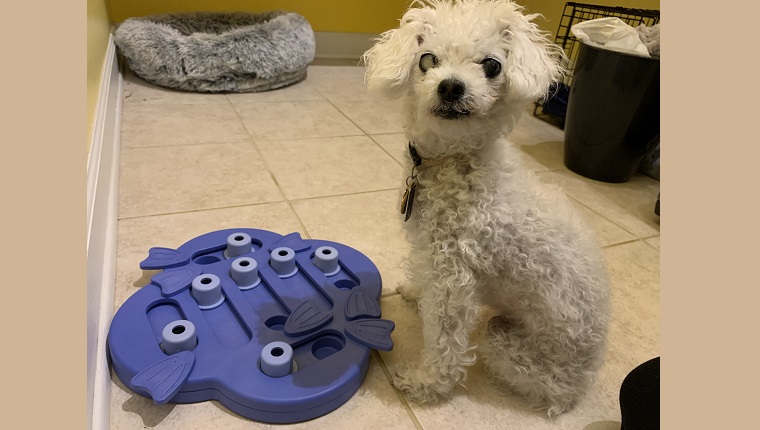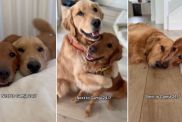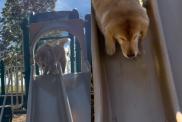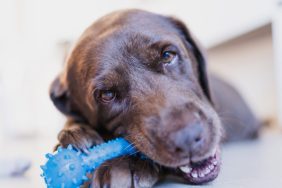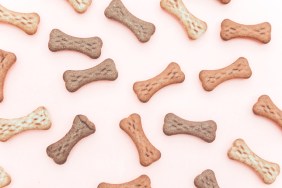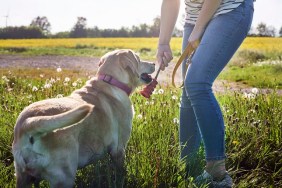My dog, Leia, is perfect, in my not-so-humble opinion, but she does have her funny quirks. One, I’ve discovered expensively, is that she is just not interested in toys.
It’s the strangest thing; she’s active, alert, curious, engaging, and very smart — all traits that would seem to make toys a great idea for her. But she just doesn’t play with them.
For example, if I try to play fetch with her, she’ll retrieve the object. But instead of bringing it back, she carries it off to her bed, like a hoarding dragon.
Tug? No thanks.
Catch? Maybe once, but I’ve got better things to do — like napping.
As any obsessed dog mom is wont to do, I’m always studying articles about the best ways to keep my dog healthy and happy. I became resigned to the fact that Leia did not seem interested in toys.
But the more I read about the importance of mental enrichment, the more I wished to find something to stimulate her mind, especially in long stretches when she’d be by herself during the day while her dog dad and I were at work.
Why Is Enrichment Important?
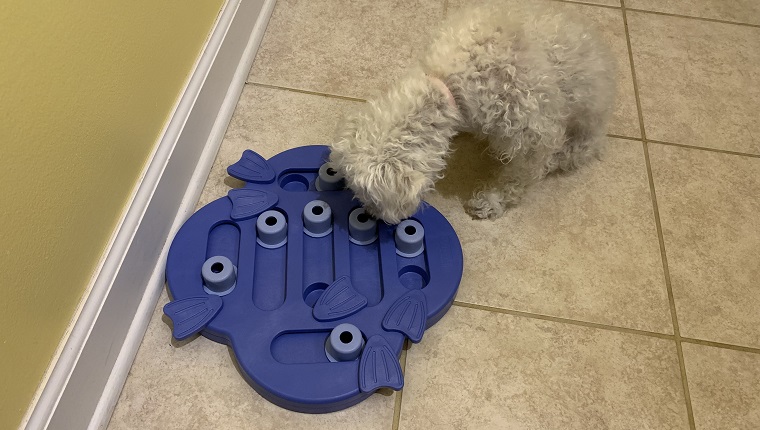
Mental stimulation is key in bringing out your dog’s best behavior and health. Enriching activities that mimic your dog’s natural behaviors, like digging, licking, chewing, sniffing, and so on, enables them to get any of those instinctual actions out of their system in a healthy, productive way, rather than destructive.
Like in humans, stimulating dogs’ minds promotes cognitive health all throughout their lifespan. Indeed, the old phrase “can’t teach a dog new tricks” was disproven in the 1970s, showing that mental stimulation can be even more important to senior dogs.
We’ve seen this in humans, too, that it’s beneficial to seniors’ cognitive health to try new activities or hobbies.
After reading how important enrichment was for dogs, especially for our senior, and with transitioning back to working in the office more, leaving Leia by herself, I felt determined to try to find an enriching toy she’d actually like.
Picking The Right Toy
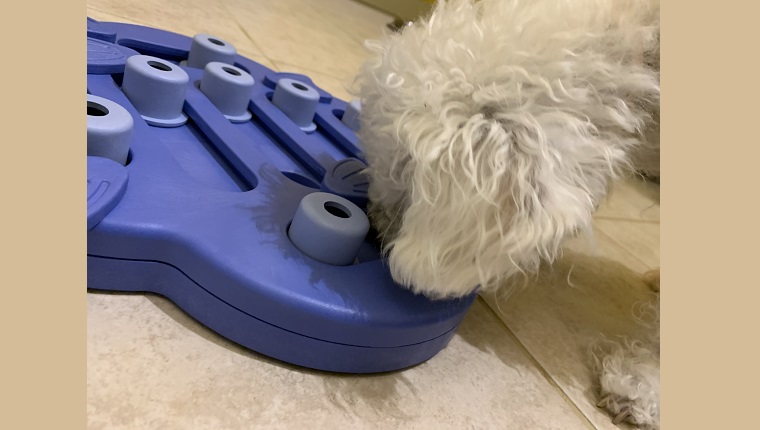
Leia is a licker — count me lucky for getting tons of kisses from her — so a lick mat would seem to make sense for a toy that would encourage her natural behavior.
Lick mats are very popular enrichment toys, due to their simplicity and appeal to dogs’ natural instinct to lick. While it’s an activity humans usually reserve for ice cream, licking is multipurpose for dogs. It’s not just for taste, but the activity also relieves stress, anxiety, pain, and boredom. That makes a lick mat a natural mental stimulation tool for enrichment.
However, while Leia adores peanut butter, she has a strange habit after eating it: she licks her fur, making a sticky mess in her hair. Since I’d have to wash or scrub it out each time, which is not her favorite, we don’t give it to her anymore. As lick mats are designed for you to spread soft foods on top of, that took this category out of the running.
While I’m first and foremost a fan of Leia’s, I’m also a huge dog fan in general. I follow many dog celebrities and shelters on social media. Seeing stimulating toys that other dogs liked really helped to give me ideas to try with Leia. I saw many animals enjoying treat puzzle toys, and with Leia’s adoration of treats, I thought that this toy might engage her interest.
Believe it or not, searching on Amazon helped a lot, too. I simply typed in “puzzle treat toy” and found this highly-rated bestseller option –the Hide-n-Slide Interactive Puzzle Game, by Nina Ottosson/Outward Hound. Conveniently, Amazon organized the listing with multiple options for levels and designs.
It was a bit of a tough choice, as Leia is very smart and good at problem-solving but, again, does not have much practice with toys due to lack of interest. I decided on a Level Two puzzle toy, as Level One looked too easy for her.
Even before introducing the puzzle toy to Leia, I was a huge fan. It’s made of durable, easy-to-wash materials, free of BPA, PVC, and phthalates.
It comes with different difficulty options built-in, too. You can fill the little wells with small treats or bits of kibble. The knobs can slide over the wells, or the fin-shaped levers can swing over them — two different methods of solving the puzzle.
Also, the puzzle was a versatile size and easy to manipulate, not spring-loaded — perfect for our little six-pound senior.
Introducing Leia To Her Puzzle
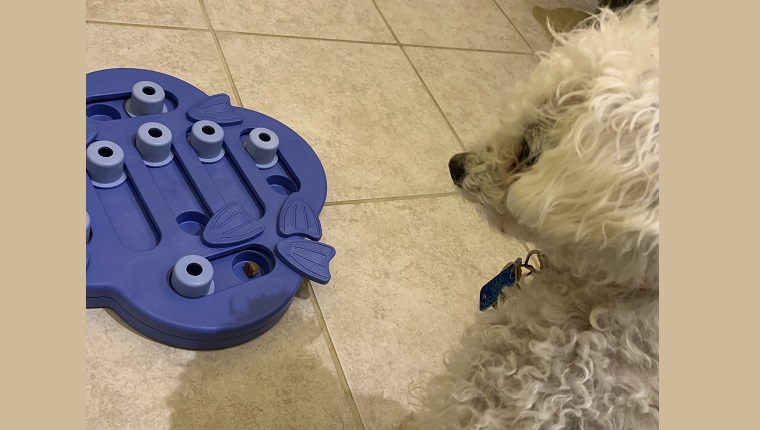
As expected, when I introduced the puzzle toy to Leia, she didn’t know what to do with it. I kept tapping on it and speaking in an excited voice to her, so she was paying attention with interest, but she still didn’t interact with it besides sniffing it.
Unlike other toys, at least this smelled like food, so that definitely intrigued her.
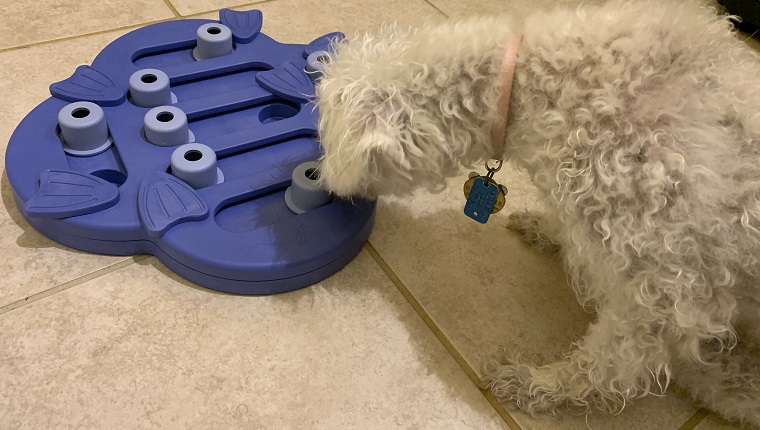
I kept encouraging her when she showed interest in the toy, with praise and petting. After a while, she was still looking at me like she didn’t know what I was asking of her. So, I slid the pegs to show her the treat and how the pegs worked before closing them again and tapping them.
I am a huge fan of Dr. Irene Pepperberg’s, her late parrot Alex, and the enormous strides they made for animal science/human-animal bonding. Her primary method for teaching him was modeling. I love the idea, and I’ve used it for both my late guinea pig, Oreo, and with Leia before. So I thought to give it a go — using my nose on the pegs to slide them.
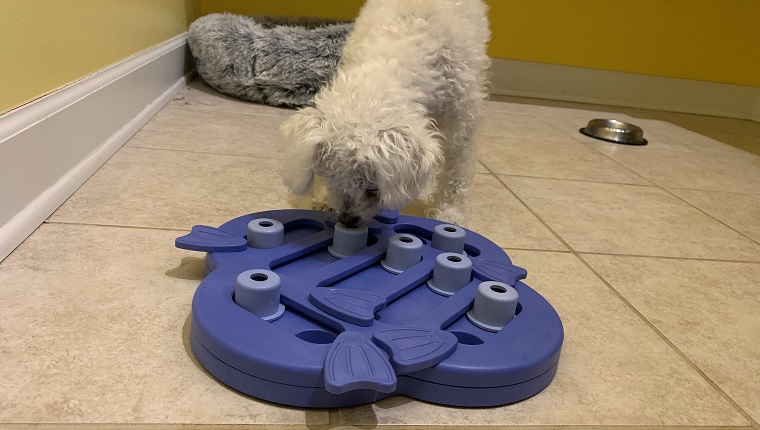
I am a very proud mama to report that Leia actually got the hang of this pretty quickly! It only took about two sessions of the tap/exemplify process for her to start doing it herself!
She also seemed very proud, tail wagging furiously as she gobbled down the spoils of her efforts.
Playing With A Toy, One Step At A Time
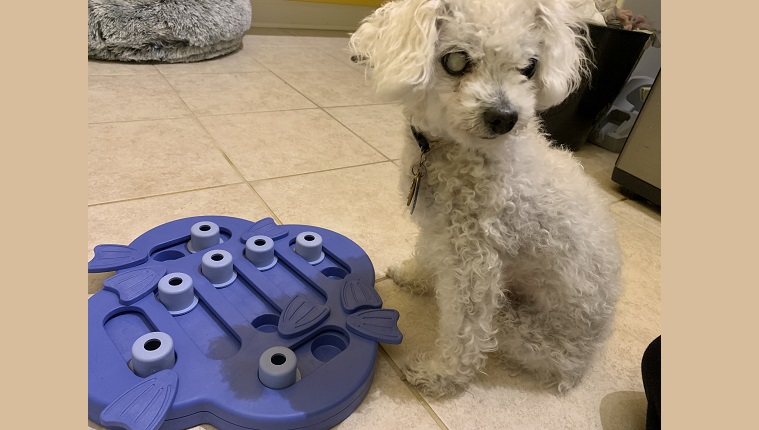
I’m ecstatic Leia has figured out her toy and seems to enjoy using it. Curiously, so far, she only seems to use it when I’m next to her, watching and encouraging her. I don’t show her how it works anymore, I just use verbal praise.
I suspect it might be because she’s not used to receiving food this way, and that her previous experience with enclosed food was that it was forbidden, which didn’t stop her from getting into things she shouldn’t have a few stressful times.
Ideally, I would like her to recognize this toy as “hers,” her toy to play with, whenever it’s out, whenever she wants to. Now, it seems she’s using it to please me, as she will only approach it when invited.
A few times, she cleared the whole puzzle while I’ve been gone, but I always have to invite her to play with it to start. When I don’t, it goes untouched.
It’s endearing, if a bit perplexing, as I know she loves the treats and looks like she’s having fun using it. I suspect repetition and continued encouragement will show her that it’s hers.
I’m absolutely thrilled we’ve finally found a toy our sweet girl is interested in and enjoys. I look forward to seeing it get even easier for her, and then we will use the levers and see how she does with those.
Do you have any tips on getting Leia to recognize this toy as hers and use it more independently? How do you get your dog interested in new toys? I would love to hear your advice in the comments below!
